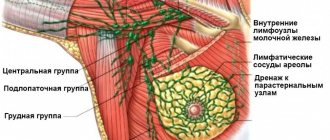Neither laparoscopy nor hysteroscopy is performed routinely or at the pregnancy planning stage without sufficient indications. Therefore, a woman, receiving good results from annual ultrasounds and gynecological examinations, does not even suspect that she may not be able to bear a child. Spontaneous miscarriages can be repeated many times until extensive gynecological diagnostics are completed using invasive techniques.
This situation is typical for a pathology called “incomplete intrauterine septum.” This is a congenital malformation that occurs quite often - in 2-3% of women. In this case, the uterus is divided into 2 parts, which are of different lengths. Sometimes the intrauterine septum (intrauterine septum or septum) even extends from bottom to top (then it is called complete).
Getting pregnant and increasing the chances of bearing a child with this diagnosis is only possible with the help of surgery.
How does an intrauterine anomaly occur?
At 3-4 gestational weeks, the primary sex gland forms in a fetus of either sex. If it is a boy, then at week 7 this gland turns into 2 testicles and begins to produce testosterone. If it is a girl, then the ovaries form later - at 8-10 weeks.
By the 5th gestational week, the embryo has 2 pairs of reproductive ducts: Wolffian and Müllerian. If by the 8th week these structures do not sense testosterone, then the Wolffian ducts partially die, and a small section of them takes part in the formation of the kidney.
The Müllerian ducts come together and grow together, forming the uterus. The common wall with which they grow to each other dissolves by 19-20 intrauterine weeks to form one cavity. If this does not happen, and the wall with which the ducts are fused is not destroyed along its entire length or partially, a developmental anomaly is formed - a uterine cavity divided in two. This is what an intrauterine septum is.
48-55% of cases of all anomalies of female genitalia are a septum in the uterus. The most commonly diagnosed is an incomplete septum, 1-6 cm long; A completely wall-divided uterus (from its fundus to the canal in the cervix) is much less common. This defect is often combined with abnormalities of kidney development.
Reasons for the development of the intrauterine septum
How does an intrauterine septum occur? The uterus is formed by the Müllerian ducts. As a result of a natural process, which is typical for the 19-20th week of gestation, the median septum resolves and a single uterine cavity is formed. If this does not happen, the median septum is preserved.
Also, an intrauterine septum can occur for the following reasons:
- infectious diseases of the mother (rubella, measles, toxoplasmosis, etc.);
- heredity;
- drug effects;
- severe toxicosis during pregnancy;
- severe endocrine diseases of the mother (diabetes mellitus, etc.);
- ionizing radiation;
- poor nutrition;
- bad habits.
Quite often, the intrauterine septum may not manifest itself for a long time. That is why women often learn about this pathology through accidental diagnosis.
Causes of the anomaly
The causes of the formation of an intrauterine septum are rarely genetic. Basically, this is the impact of unfavorable factors on the fetus precisely during the period when the formation of the uterus occurs - from 10 to 20 weeks.
Damaging agents may include:
- mother's bad habits;
- toxicosis of pregnancy;
- infections suffered by the mother, especially those included in the TORCH group: toxoplasmosis, rubella, chlamydia, herpes, and measles;
- diabetes mellitus in a pregnant woman – existing before conception or appearing during pregnancy (gestational diabetes);
- taking toxic medications;
- the influence of industrial and household toxins on the body of the mother and fetus;
- disturbances in the formation or attachment of the placenta, which coincides in time with the formation of the uterus - 12-16 weeks;
- poor maternal nutrition, when the normal daily need for proteins, essential amino acids, vitamins and microelements is not met;
- exposure of the mother to ionizing radiation.
Intrauterine septum and its effect on the possibility of conception, pregnancy and childbirth
Neither laparoscopy nor hysteroscopy is performed routinely or at the pregnancy planning stage without sufficient indications.
Therefore, a woman, receiving good results from annual ultrasounds and gynecological examinations, does not even suspect that she may not be able to bear a child.
Spontaneous miscarriages can be repeated many times until extensive gynecological diagnostics are completed using invasive techniques.
This situation is typical for a pathology called “incomplete intrauterine septum.” This is a congenital malformation that occurs quite often - in 2-3% of women. In this case, the uterus is divided into 2 parts, which are of different lengths. Sometimes the intrauterine septum (intrauterine septum or septum) even extends from bottom to top (then it is called complete).
Getting pregnant and increasing the chances of bearing a child with this diagnosis is only possible with the help of surgery.
How does an intrauterine anomaly occur?
At 3-4 gestational weeks, the primary sex gland forms in a fetus of either sex. If it is a boy, then at week 7 this gland turns into 2 testicles and begins to produce testosterone. If it is a girl, then the ovaries form later - at 8-10 weeks.
By the 5th gestational week, the embryo has 2 pairs of reproductive ducts: Wolffian and Müllerian. If by the 8th week these structures do not sense testosterone, then the Wolffian ducts partially die, and a small section of them takes part in the formation of the kidney.
The Müllerian ducts come together and grow together, forming the uterus. The common wall with which they grow to each other dissolves by 19-20 intrauterine weeks to form one cavity.
If this does not happen, and the wall with which the ducts are fused is not destroyed along its entire length or partially, a developmental anomaly is formed - a uterine cavity divided in two.
This is what an intrauterine septum is.
48-55% of cases of all anomalies of female genitalia are a septum in the uterus. The most commonly diagnosed is an incomplete septum, 1-6 cm long; A completely wall-divided uterus (from its fundus to the canal in the cervix) is much less common. This defect is often combined with abnormalities of kidney development.
Causes of the anomaly
The causes of the formation of an intrauterine septum are rarely genetic. Basically, this is the impact of unfavorable factors on the fetus precisely during the period when the formation of the uterus occurs - from 10 to 20 weeks.
Damaging agents may include:
- mother's bad habits;
- toxicosis of pregnancy;
- infections suffered by the mother, especially those included in the TORCH group: toxoplasmosis, rubella, chlamydia, herpes, and measles;
- diabetes mellitus in a pregnant woman – existing before conception or appearing during pregnancy (gestational diabetes);
- taking toxic medications;
- the influence of industrial and household toxins on the body of the mother and fetus;
- disturbances in the formation or attachment of the placenta, which coincides in time with the formation of the uterus - 12-16 weeks;
- poor maternal nutrition, when the normal daily need for proteins, essential amino acids, vitamins and microelements is not met;
- exposure of the mother to ionizing radiation.
Symptoms
This malformation does not have noticeable manifestations in everyone: most girls report only slightly more painful menstruation than they should have. But this does not force them to see a doctor, because they do not know what normal periods feel like.
The second manifestation of the intrauterine septum is uterine bleeding, which sometimes develops in the middle of the cycle, but often appears during menstruation, which increases the volume of the latter.
The third and rarest manifestation is primary amenorrhea, when menstruation does not occur at all.
Most often, the anomaly is discovered only when a woman begins to undergo in-depth examination for reasons such as the inability to conceive or recurrent miscarriage. The disease can also be detected if, based on the detection of an abnormal kidney structure on an ultrasound, the doctor also recommends a thorough examination of the reproductive organs.
Intrauterine septum and pregnancy
The presence of an intrauterine septum can affect a woman's ability to become pregnant in one of two ways.
Firstly, it can cause infertility. In 21-28% of women with this defect, primary infertility is observed - when pregnancy has never occurred. In 12-19%, this is a secondary condition, when a woman managed to give birth to one child, but after that she can no longer get pregnant.
Secondly, sometimes a septum causes miscarriage. In the first trimester, the risk of this phenomenon is high – 28-60%.
This is due to the fact that there is a high chance that the embryo will not attach to the wall of the uterus, which will give the placenta the opportunity to develop and provide sufficient nutrition to the developing organism.
The embryo is often attached precisely to the intrauterine septum - a formation that does not have blood vessels and, accordingly, is unable to perform a trophic function.
During pregnancy in the 2nd trimester, if the fetus was able to attach itself to the wall of the uterus and not to the septum, the risk of miscarriage still exists, although much lower - only 5%. One of the reasons is due to the fact that the intrauterine membrane, especially if it is full, leads to non-closure of the walls of the cervical canal.
As a result, the cervix loses its ability to withstand intrauterine pressure, which increases as the fetus grows, and without timely correction, a miscarriage may occur. The second reason for miscarriage in the second trimester is that an obstruction inside the uterus prevents the cavity from expanding in proportion to the growing fetus.
But the statistics are comforting: in 50% of cases, a septum in the uterine cavity does not interfere with either conception or gestation. Although its presence increases the risk that the fetus will be located transversely, and a cesarean section will be required for its birth.
The influence of pathology on the course of labor
An intrauterine septum can cause:
- Premature birth. They begin due to the pressure of the septum on the fetus, which has already become quite large.
- Deterioration of the contractility of the uterus: the muscles of the second half of the uterus (on the side where the fetus did not develop) did not stretch as much as it grew. As a result, incoordination or weakness of labor develops. Less commonly, the intrauterine membrane becomes the cause of a life-threatening condition for the mother in labor, when after the end of labor the uterus relaxes, which causes heavy bleeding, which can only be stopped by removing it.
Such complications are more typical for a complete intrauterine membrane.
Diagnostics
A septate uterus is an abnormality that is often difficult to diagnose. It cannot be detected during a gynecological examination.
A pelvic ultrasound also turns out to be uninformative, and if it reveals a thin-walled structure in the middle of the uterine cavity, it is not clear whether it is an intrauterine membrane or a bicornuate uterus.
The hydrosonography method is more informative - conducting ultrasound diagnostics against the background of filling the uterine cavity with sterile liquid.
Hysterosalpingography - x-rays of the uterus and fallopian tubes - is only useful in 50% of cases. And even CT or MRI when determining this pathology lose their diagnostic significance.
Accurate diagnosis of the intrauterine septum is ensured only by a combination of two invasive procedures: hysteroscopy and laparoscopy.
Hysteroscopy or its subtype, fibrohysteroscopy - the introduction of an optical device into the uterine cavity - is carried out under anesthesia, since it will be necessary to open the cervix, which has a huge number of nerve receptors, and then fill the uterus itself with gas or liquid. This study allows you to see the connective tissue membrane with your eyes, evaluate its length and thickness, and also examine the volume of the uterine cavity. The study is carried out in the first half of the menstrual cycle, while the endometrium is still quite small.
The diagnosis of the length of the intrauterine septum is made based on the data obtained (this is important for treatment). As a result, we distinguish:
- complete septum: extends to the internal or external pharynx;
- incomplete – 10-40 mm long;
- septum on a wide base (triangle in projection).
Laparoscopy is the introduction of an optical device into the cavity of the abdomen and pelvis through incisions. It allows you to examine the uterus “from above”, to see that there are no two muscular ridges (that is, the uterus is not bicornuate), and the organ itself can be expanded in the transverse direction. Laparoscopy allows you to see if the uterine halves are asymmetrical. The method also evaluates the condition of the ovaries, fallopian tubes, and peritoneum.
Considering that only a combination of hysteroscopy and laparoscopy is the “gold standard” in diagnosis, determining the intrauterine septum during pregnancy is difficult.
Treatment
The septum cannot be removed by any method other than surgery.
But not all surgeons are ready to do this only on the basis of a diagnosis: many undertake surgery only for primary infertility or recurrent miscarriage, but not if the patient has a history of one successful pregnancy.
They explain this by the fact that the chance of a successful pregnancy after surgery is not 100%, but 85-90%. Other experts, on the contrary, believe that the very presence of pathology serves as an indication for its removal.
Dissection of the intrauterine septum is carried out under full visual control through a hysteroscope.
At the moment, the operation consists of dissecting the intrauterine septum. It is performed through a hysteroscope under full visual control. Anesthesia - general.
As preoperative preparation, antigonadotropin drugs are sometimes prescribed for a course of 2-3 months.
They cause artificial menopause, but at the same time reduce the thickness of the endometrium, and thereby reduce the volume of blood lost during the intervention.
If the septum is thin, it is cut with endoscopic scissors or a laser. In the case of a thick or vascular-rich septum, it is removed with a hysteroresectoscope - a “loop” inserted through the hysteroscope channel, which is “cut” with an electric current, while simultaneously cauterizing the bleeding vessels.
If the uterine septum was complete and entered the cervical canal, its cervical part is preserved in order to prevent the development of isthmic-cervical insufficiency, which complicates the normal course of pregnancy.
If the uterine cavity has been deformed, after removing the septum, it is reconstructed. The total duration of the intervention is up to 60 minutes.
After the operation, you should not immediately plan a pregnancy: you will have to take hormonal estrogen medications for 2-3 months to prevent the formation of intrauterine adhesions. You may need to use contraception for up to 13 months after surgery.
Source: https://ginekolog-i-ya.ru/vnutrimatochnaya-peregorodka.html
Symptoms
This malformation does not have noticeable manifestations in everyone: most girls report only slightly more painful menstruation than they should have. But this does not force them to see a doctor, because they do not know what normal periods feel like.
The second manifestation of the intrauterine septum is uterine bleeding, which sometimes develops in the middle of the cycle, but often appears during menstruation, which increases the volume of the latter.
The third and rarest manifestation is primary amenorrhea, when menstruation does not occur at all.
Most often, the anomaly is discovered only when a woman begins to undergo in-depth examination for reasons such as the inability to conceive or recurrent miscarriage. The disease can also be detected if, based on the detection of an abnormal kidney structure on an ultrasound, the doctor also recommends a thorough examination of the reproductive organs.
Is it possible to give birth with a bicornuate uterus? Doctors' answers
The human body is a mystery and has intrigued the minds of scientists throughout human existence. Of particular interest is the woman's body as a source of new life.
Despite the fact that the basic principles of structure are the same for all people, each organism is unique and has its own characteristics. Depending on their nature, experts talk about the presence of developmental anomalies.
In one case, the tissue or organ may be modified, in another - absent or duplicated. The last variant of deviation from the norm of development is a bicornuate uterus.
This structural feature is considered the most common among uterine developmental anomalies, but in general it is quite rare, occurring in 0.1% - 0.5% of women.
But do women diagnosed with a bicornuate uterus understand that such development is not a death sentence for their reproductive function? Does it reduce their anxiety? I think no.
Each of them is concerned about the question of whether pregnancy is possible with a bicornuate uterus, how does it proceed and what features does it have? What is a bicornuate uterus in women?
Let's talk about all this in order.
What is a bicornuate uterus in women?
It is no secret that the formation and initial development of all human systems and organs occurs in the mother’s womb.
Thus, the female genital organs are formed from approximately 7 to 14 weeks of fetal development, and the uterus is formed due to the fusion of the Müllerian ducts.
If this process deviates somewhat from the normal pace, there are frequent cases of abnormal development, in which the uterus does not develop correctly.
In this regard, a two-horned uterus (lat. Uterus bicornis) is a type of violation of the intrauterine development of the girl’s reproductive system, expressed in the division of the uterine cavity into two parts, merging into one vagina.
Types of bicornuate uterus and their features
Today, gynecology distinguishes 3 types of bicornuate uterus, each of which has its own characteristics and a certain impact on the possibility of motherhood.
So, a bicornuate uterus can be complete, incomplete and saddle-shaped (or arcuate). Each type is discussed in more detail in the table below.
(To view from a mobile phone, rotate it to a horizontal position to fully display the table)
ViewImageFeaturesBicornuate uterus and pregnancyComplete bicornuate uterusIncomplete bicornuate uterusSaddle bicornuate uterus
| Complete splitting of the uterine cavity by the septum, starting from the uterosacral ligaments. As a result, two cavities (two horns) are formed, flowing into one cervix and vagina. The angle between the horns may vary. | Possible. It all depends on the development of the horns. Depending on the results of the examination, metroplasty may be indicated. |
| The septum is located in the upper 1/3 of the uterus, so the horns are separated shallowly. Therefore, they most often have approximately the same size and shape. | Possible. |
| The uterine cavity is slightly changed, the horns practically merge, and there is a saddle-shaped depression in the fundus. | Possible. |
Causes of abnormal development
There is no single specific reason that leads to the formation of this particular developmental pathology in the literature.
However, there are factors whose impact in the first trimester of pregnancy can lead to abnormalities of the fetal reproductive system:
- Intoxication: the mother’s use during pregnancy of such harmful and aggressive agents as tobacco, alcohol, drugs, potent and any other medications without a doctor’s prescription.
- Psychotraumatic circumstances and/or chronic stress.
- Acute lack of adequate nutrition and vitamin deficiency.
- Some diseases of the endocrine system (thyrotoxicosis, diabetes mellitus) and cardiovascular system (heart disease).
- Infectious diseases such as measles, rubella, toxoplasmosis, influenza, as well as sexually transmitted infections (syphilis and others).
- Problems with fetal nutrition and chronic oxygen starvation.
- Acute toxicosis during pregnancy.
- A genetic factor that is most often not taken into account due to lack of awareness.
Due to the influence of these factors in the first weeks of pregnancy, there are frequent cases of abnormal development of not only the reproductive system, but also the baby’s urinary system. Therefore, it is extremely important that the expectant mother pays due attention to her health, sees a doctor and takes care of the unborn child.
You might be interested in: How to protect yourself from rubella during pregnancy
Dangers of a bicornuate uterus and its symptoms
Is a bicornuate uterus bad, what dangers does this anomaly pose and what consequences can it lead to?
First , this diagnosis can cause infertility and the inability to bear a baby, that is, miscarriages . However, this is not always the case; it all depends on the degree of development of the horn or horns of the uterus. The more pronounced the septum of the uterine cavity, the higher the chance of losing the child.
Secondly, this feature often causes abnormal spontaneous uterine bleeding.
And although a bicornuate uterus causes infertility in about half of the cases, its detection is not as obvious as it seems. During a routine gynecological examination, it is detected extremely rarely. Most often, a woman learns about this structural feature in one of three cases:
- diagnosis in connection with the problem of infertility or miscarriage;
- thorough diagnosis at the stage of pregnancy planning;
- directly during pregnancy.
In connection with the above, a woman may not even be aware of her illness. However, there are still some signs that may suggest something is wrong:
From the side of gynecology:
- uterine bleeding;
- pain in the lower abdomen as during menstruation;
- algodismenorrhea;
From the side of reproductive function:
- miscarriages (especially in the 1st trimester of pregnancy);
- premature birth;
- infertility;
- frozen pregnancy;
From the placenta:
- location anomalies;
- premature detachment;
- placental bleeding;
On the fetal side:
- breech presentation;
- transverse or oblique position;
- oxygen starvation and lack of nutrition in general;
From the side of labor:
- isthmic-cervical insufficiency;
- premature birth;
- violation of contractile function of the uterine muscles;
- postpartum bleeding.
It must be remembered that these symptoms do not appear in everyone and not always, as well as the fact that a bicornuate uterus and pregnancy is possible and quite often it is successful.
If any symptom or several are noticed, you should immediately seek qualified help from a gynecologist for diagnostic measures.
Diagnosis of bicornuate uterus
From all that has been said above, it follows that diagnosing a bicornuate uterus using conventional gynecological examination methods is ineffective; additional research methods are required. Only after a thorough examination can the doctor make a conclusion and diagnose a “bicornuate uterus”, and build a tactic for further treatment.
Modern gynecology has a wide range of diagnostic capabilities, so gynecological examination involves the use of:
- probing of the uterine cavity and ultrasound examination of the pelvis using sensors;
- conventional and ultrasound hysterosalpingography;
- MRI;
- hysteroscopy;
- laparoscopy.
To make a final diagnosis of uterine malformation, hysteroscopy and laparoscopy are performed simultaneously. This is done to exclude the diagnosis: intrauterine septum, the picture of which is very similar to a bicornuate uterus.
Treatment of the anomaly
Since a bicornuate uterus is an anomaly of organ development, and not a disease in the broad sense of the word, treatment of this disease is carried out using surgical intervention according to indications.
The latter is the full form of a bicornuate uterus revealed during the examination as a factor of infertility after all other possible causes of reproductive dysfunction have been excluded.
The main indicator for metroplasty, according to experts, is repeated miscarriages or premature births (more than 2–3 times).
The main method of surgical removal of a bicornuate uterus is the Strassmann operation, which involves transverse dissection of the uterus during laparotomy surgery, followed by excision of the septum and the application of a longitudinal suture to the uterus.
After successful completion of the operation, the woman is fitted with an IUD (intrauterine device) for a period of 6–8 months, since an early pregnancy after Strassmann’s operation can end tragically - uterine rupture.
Despite the fact that a well-performed Strassmann operation significantly increases the chances of a successful pregnancy with subsequent delivery (in 63% of cases, a woman’s fertility is completely restored), we must remember that the risk of uterine wall rupture remains high, as well as the likelihood of developing repeated infertility due to with the possibility of formation of adhesions. It is important to follow all the recommendations of the gynecologist and carry out all necessary diagnostic and therapeutic measures in accordance with them. The process of recovery and subsequent motherhood largely depends on the woman herself.
Therefore, pregnancy with a bicornuate uterus requires close attention from doctors and from the expectant mother.
Bicornuate uterus and pregnancy: main risks
Any deviation of an organ from normal functioning is always a risk and a threat to health, and in the case of the uterus, the stakes are doubly high. The possibility of a horny uterus and pregnancy is not mutually exclusive; in fact, there are frequent cases of successful pregnancy and no less successful childbirth with this anomaly.
There are still pitfalls and they are as follows:
- “I don’t have enough space, I have nowhere to turn around,” or insufficient volume of the intrauterine cavity for normal growth and development of the fetus;
- the embryo may accidentally choose the “wrong home” and attach to the avascular septum, and, consequently, be deprived of nutrition and oxygen;
- pregnancy with a bicornuate uterus is very often accompanied by a violation of the obturator function of the uterus, which provokes the threat of miscarriage or premature birth.
If a bicornuate uterus and pregnancy occur, then experts prefer not to interfere in the process of bearing the baby unnecessarily, but to closely monitor it. Since at any time at any time with such a pathology, 2 serious complications are possible:
- Bleeding, which is often caused by placental presentation (occurs in 40–45% of cases). This suggests that the embryo decided to attach not in the back or side parts of the mother’s womb, but “closer to the exit”, to the endometrium of the lower part of the uterus.
Bloody discharge in the early stages, as well as bleeding, indicate that during the process of formation and growth, the placenta blocked the cervix of the uterus. Accompanied by pain in the lower abdomen, this sign is a harbinger of miscarriage, which occurs in 30–35% of pregnancies with a bicornuate uterus.With late bleeding after the 30th week of pregnancy, we are already talking about placental abruption.
- Frozen pregnancy.
In cases where the embryo is attached not to any wall of the uterus, but to a vascular-free septum, it cannot feed and develop. As a result, its development stops and the embryo dies. Pregnancy can also freeze when the embryo is attached in close proximity to the septum. It will simply interfere with normal growth and development, which will also lead to the death of the embryo.
Pregnancy with an arcuate (saddle-shaped) bicornuate uterus
The most favorable option for pregnancy with a bicornuate uterus is considered to be in an arcuate or saddle-type uterus due to the fact that in this case there is no septum as such, there is a small ridge in the fundus.
But even here there are plenty of possible complications. The dangers are the same as with other types of bicornuate uterus, only they appear somewhat less frequently.
The most typical complications and threats during pregnancy for a saddle-shaped bicornuate uterus are:
- Premature birth, which is most often much ahead of schedule. This is observed in 15–25% of pregnant women with this type of pathology. As a result, perinatal morbidity and newborn mortality increase.
- Malposition. With this type of uterus, it is most likely that the fetus will be positioned transversely or obliquely, which is a direct indication for surgical delivery via cesarean section. If the birth took place naturally, the woman’s recovery period is very long, since such a uterus contracts poorly and will bleed for a long time.
Two horns - two children
The human body is mysterious and unpredictable. It would seem that with a bicornuate uterus, pregnancy is unlikely, not to mention anything more. It turns out that everything is so, but not so. And pregnancy with a bicornuate uterus can not only happen, but can also turn out to be multiple.
There are cases of twin pregnancy with complete bifurcation of the uterus, that is, when the splitting of the septum reaches the cervical canal and forms two uterine cavities. In this case, the pregnancy of each fertilized follicle most often develops in different horns. This happens extremely rarely; according to statistics, twin pregnancy with a bicornuate uterus is 1 case per million.
From the point of view of obstetrics and gynecology, this pregnancy falls into the category of extreme risk of miscarriage or uterine rupture. In 90–95% of cases, such a pregnancy ends in premature birth at 32–34 weeks of pregnancy.
Intrauterine septum and pregnancy
The presence of an intrauterine septum can affect a woman's ability to become pregnant in one of two ways.
Firstly, it can cause infertility. In 21-28% of women with this defect, primary infertility is observed - when pregnancy has never occurred. In 12-19%, this is a secondary condition, when a woman managed to give birth to one child, but after that she can no longer get pregnant.
Secondly, sometimes a septum causes miscarriage. In the first trimester, the risk of this phenomenon is high – 28-60%. This is due to the fact that there is a high chance that the embryo will not attach to the wall of the uterus, which will give the placenta the opportunity to develop and provide sufficient nutrition to the developing organism. The embryo is often attached precisely to the intrauterine septum - a formation that does not have blood vessels and, accordingly, is unable to perform a trophic function.
During pregnancy in the 2nd trimester, if the fetus was able to attach itself to the wall of the uterus and not to the septum, the risk of miscarriage still exists, although much lower - only 5%. One of the reasons is due to the fact that the intrauterine membrane, especially if it is full, leads to non-closure of the walls of the cervical canal. As a result, the cervix loses its ability to withstand intrauterine pressure, which increases as the fetus grows, and without timely correction, a miscarriage may occur. The second reason for miscarriage in the second trimester is that an obstruction inside the uterus prevents the cavity from expanding in proportion to the growing fetus.
But the statistics are comforting: in 50% of cases, a septum in the uterine cavity does not interfere with either conception or gestation. Although its presence increases the risk that the fetus will be located transversely, and a cesarean section will be required for its birth.
Symptoms of a septum in the uterus
There are no characteristic signs of the presence of a septum in the uterus. This pathology is relatively rare, occurring in approximately 2% of women in the general population, and makes itself felt by such nonspecific signs as:
- primary amenorrhea
- dysmenorrhea
- infertility
- spontaneous miscarriages
- premature birth
The risk of losing a pregnancy is significantly higher in the first trimester. During this period, the probability of miscarriage is 30-60%, and in the second trimester the risk decreases to 5%. The cause of pregnancy loss may be implantation of an embryo on a septum that is unable to replace the endometrium, or isthmic-cervical insufficiency if the septum involves the cervical canal.
In addition, a septum in the uterus can cause abnormal fetal position, weak labor and bleeding. The severity of negative signs depends on the thickness and size of the septum. For example, in one case, a septum may be detected by ultrasound in the early stages of pregnancy and will not be found during a subsequent examination. The question will arise, what happened to her? It may be assumed that either the septum was very thin and ruptured due to the growth of the uterus and fetus, or it was pressed against the wall of the uterus. In another case, the septum may be much denser, and the volume of the uterus throughout pregnancy will be significantly less than necessary. It is quite obvious that this will affect the growth and development of the fetus and disrupt the physiological course of pregnancy.
The influence of pathology on the course of labor
An intrauterine septum can cause:
- Premature birth. They begin due to the pressure of the septum on the fetus, which has already become quite large.
- Deterioration of the contractility of the uterus: the muscles of the second half of the uterus (on the side where the fetus did not develop) did not stretch as much as it grew. As a result, incoordination or weakness of labor develops. Less commonly, the intrauterine membrane becomes the cause of a life-threatening condition for the mother in labor, when after the end of labor the uterus relaxes, which causes heavy bleeding, which can only be stopped by removing it.
Such complications are more typical for a complete intrauterine membrane.
Diagnostics
A septate uterus is an abnormality that is often difficult to diagnose. It cannot be detected during a gynecological examination. A pelvic ultrasound also turns out to be uninformative, and if it reveals a thin-walled structure in the middle of the uterine cavity, it is not clear whether it is an intrauterine membrane or a bicornuate uterus. The hydrosonography method is more informative - conducting ultrasound diagnostics against the background of filling the uterine cavity with sterile liquid.
Hysterosalpingography - x-rays of the uterus and fallopian tubes - is only useful in 50% of cases. And even CT or MRI when determining this pathology lose their diagnostic significance.
Accurate diagnosis of the intrauterine septum is ensured only by a combination of two invasive procedures: hysteroscopy and laparoscopy.
Hysteroscopy or its subtype, fibrohysteroscopy - the introduction of an optical device into the uterine cavity - is carried out under anesthesia, since it will be necessary to open the cervix, which has a huge number of nerve receptors, and then fill the uterus itself with gas or liquid. This study allows you to see the connective tissue membrane with your eyes, evaluate its length and thickness, and also examine the volume of the uterine cavity. The study is carried out in the first half of the menstrual cycle, while the endometrium is still quite small.
The diagnosis of the length of the intrauterine septum is made based on the data obtained (this is important for treatment). As a result, we distinguish:
- complete septum: extends to the internal or external pharynx;
- incomplete – 10-40 mm long;
- septum on a wide base (triangle in projection).
Laparoscopy is the introduction of an optical device into the cavity of the abdomen and pelvis through incisions. It allows you to examine the uterus “from above”, to see that there are no two muscular ridges (that is, the uterus is not bicornuate), and the organ itself can be expanded in the transverse direction. Laparoscopy allows you to see if the uterine halves are asymmetrical. The method also evaluates the condition of the ovaries, fallopian tubes, and peritoneum.
Considering that only a combination of hysteroscopy and laparoscopy is the “gold standard” in diagnosis, determining the intrauterine septum during pregnancy is difficult.
Removal of a septum in the uterus
Considering the negative consequences a complete septum in the uterus can have for pregnancy, most experts advise removing it promptly before planning begins. And at the same time, many doctors do not recommend touching an incomplete septum, arguing that there is no indication for this, and in 50% of cases pregnancy occurs and develops well even without surgical intervention.
In order to prepare for the operation, special hormonal drugs can be prescribed for a course of 2-3 months to reduce the thickness of the endometrium, or the operation can be performed in the first phase of the menstrual cycle without prior preparation. This point is decided by the doctor individually.
The intrauterine septum is removed by hysteroresectoscopy under general anesthesia. In some cases, under mandatory laparoscopic control. In the vast majority of cases, this technique allows not to damage the integrity of the muscular layer of the uterus, which guarantees the preservation of the normal contractility of the myometrium during childbirth. Also, the likelihood of complications such as intrauterine synechiae and adhesions in the pelvic cavity is reduced to a minimum, and postoperative bleeding is insignificant. To prevent infectious complications during surgery, the patient is given an antibiotic intravenously.
After surgery, planning is permitted after 3-4 months, depending on the condition of the endometrium. This procedure is considered minimally invasive and at the same time greatly increases the chances of getting pregnant and successfully bearing a child, provided that the problem was in the septum and there are no other obstacles to the pregnancy in the woman’s health. They are usually released from the hospital the next day. After 2-3 months, a control hysteroscopy can be performed to assess the effectiveness of the operation.
If a septum in the uterus during pregnancy was discovered during a routine ultrasound, then doctors adhere to the tactics of active monitoring and increased attention, provided that the embryo develops according to its timing. It is not possible to remove a septum during pregnancy. Subsequently, the intrauterine septum often becomes an indication for cesarean section
Treatment
The septum cannot be removed by any method other than surgery. But not all surgeons are ready to do this only on the basis of a diagnosis: many undertake surgery only for primary infertility or recurrent miscarriage, but not if the patient has a history of one successful pregnancy. They explain this by the fact that the chance of a successful pregnancy after surgery is not 100%, but 85-90%. Other experts, on the contrary, believe that the very presence of pathology serves as an indication for its removal.










